
A company’s communication binds teams together and helps ensure everyone works towards the same goals. On the other hand, a lack of communication results in disoriented teams, demotivated employees, and costly mistakes.
When internal communication fails, it affects the entire business. The same employees, who are unclear about the company’s vision and objectives, are expected to collaborate with external stakeholders. Unsurprisingly, the result is poor customer service and low returns on investments.
That’s why crafting a robust communication plan is essential. The right strategy allows you to create a common understanding of goals and objectives within each team and across departments. In this article, well discuss strategies for creating a winning communication plan and provide a template to get you started.’
The Cost of Poor Communication + The Need for a Better Approach
A staggering 48% of employees and HR professionals identify insufficient communication as the primary source of workplace stress. In 2021, a mere 21% of the global workforce reported feeling engaged in their jobs. This lack of engagement or active disengagement resulted in a colossal $8.8 trillion loss in productivity, equivalent to 9% of the worldwide GDP.
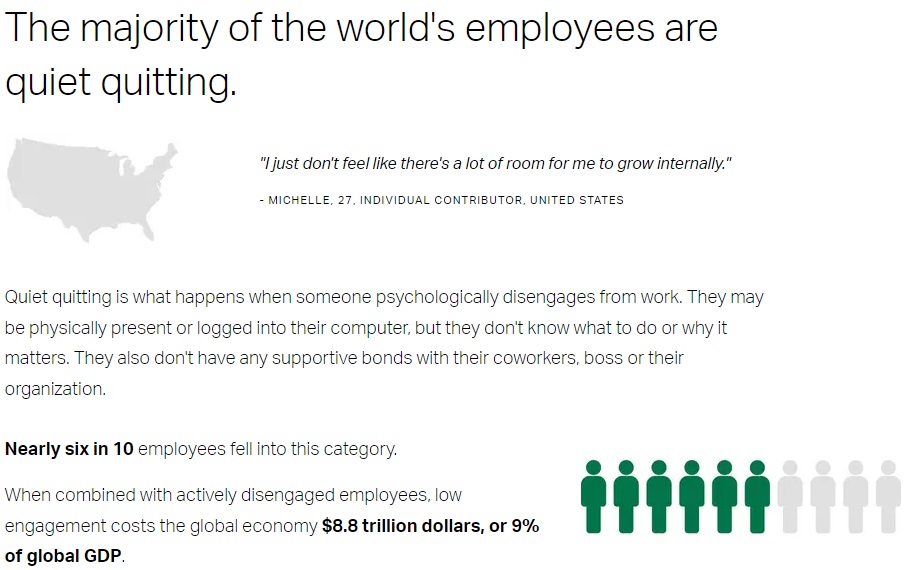
In 2022, 56% of organizations adopted hybrid or fully remote work arrangements. However, without a structured communication strategy, employees struggle to adapt to these changes. Remote teams commonly experience trust issues, misalignment with company goals, and challenges in comprehending their colleagues' perspectives. As a result, 32% of individuals feel that communication with coworkers and clients has become more difficult over the past year.
Inefficient communication negatively impacts various aspects of an organization. The following overview from a study by Project.co highlights the key areas affected:
Key Elements in a Successful Communication Plan?
With only 4% of companies describing themselves as efficient, the need for a communication plan that everyone follows has never been more urgent. A communication plan is a living document that guides an organization’s internal and external communication.
The communication plan outlines who needs to communicate what information, when you should communicate it, and how you should communicate it. Here are the key elements of a successful communication plan:
1. Objectives
Why is the communication plan necessary? What goals does it help achieve?
Describe the purpose and objectives of the communication plan. For example, if you’re launching a new product, the communication plan could be to announce the launch, build buzz around it, and drive sales.
2. Target Audience
Who needs to be aware of communication? Are you targeting internal stakeholders, external customers, or both? Describe different target audiences for each type of message. For example, the product launch message could target internal stakeholders like employees, customers, potential customers, and investors.
3. Key Messages
What do you need to communicate? What language should be used?
For example, you could include key messages like product features and benefits, customer testimonials, or special offers. Make sure the language is consistent across all channels for maximum impact.
4. Communication Channels
The choice of communication tools is crucial for both internal coordination among employees and external engagement with customers or the public. Will it be email, social media, blog posts, or video content? Or perhaps a combination of these? Moreover, how frequently should the communication occur to maintain engagement without overwhelming the recipients?
Internal communication platforms like emails, intranet systems, and project management software like Slack or Trello can be instrumental. They facilitate the sharing of information, updates, and feedback among employees, teams, and departments. For instance, emails can be used for official announcements, while platforms like Slack can host real-time discussions and quick updates.
On the other hand, external communication aimed at customers, investors, or the public may leverage social media, blog posts, video content, and email newsletters. For example, you could use emails to announce a new product launch to your internal teams while simultaneously launching a social media campaign to create buzz among customers. Video tutorials on how the product works can be shared both internally for training purposes and externally for marketing and customer education. Blog posts highlighting the features and benefits of the product can also serve dual purposes: educating both your employees and your external audience.
By carefully selecting and utilizing a mix of communication channels, you can effectively bridge the gap between internal stakeholders and external audiences, ensuring everyone is well-informed and aligned with your company's goals and initiatives.
5. Timeline and Frequency
What is the schedule for implementing the communication plan? When will each message be sent out, who will receive them, and what will be the frequency?
Establishing distinct timeframes for distributing communications is crucial to any communication plan, as it guarantees prompt and orderly delivery of messages. Additionally, determining a suitable frequency aids in sustaining engagement without inundating the target audience.
For instance, outline the timing for releasing the product launch announcement, sharing video tutorials, and publishing blog posts. Afterward, provide a comprehensive timeline that includes anticipated dates and times for each communication event.
6. Roles and Responsibilities
Who will be responsible for each communication task?
For example, the product launch team could include the marketing manager, customer service manager, and content writer. Define what tasks each person is responsible for and the timeline.
How to Write and Develop an Effective Communication Plan
In a survey by Gallagher, 74% said internal communication supports culture and belonging. A communication plan breaks silos and encourages collaboration. It bridges the gap between departments and improves employee communication and engagement.
Here’s how to write and develop an effective communication plan:
1. Audit
Understand where you are, and what you need to do. Many companies start off with a communication plan. Identify gaps and challenges, analyze the current situation, and define what to do.
Is communication all over the place? Are team members sharing important updates on Slack where they can get lost? Do you have a team newsletter to keep everyone in the loop? Audit these communications, determine what needs to be improved, and outline your communication plan.
2. Define Clear Goals and Objectives
What outcomes do you want to achieve with the communication plan? For example, do you want to increase employee engagement, save time on meetings, or build a better customer relationships?
SMART goals are specific, measurable, attainable, relevant, and time-based. Define your objectives in terms of SMART goals so you can track progress throughout the communication plan. For example, “Increase employee engagement by 10% in the next six months.”
3. Develop Clear, Concise, and Engaging Messaging
Ensure your messaging aligns with your goals and objectives, and maintain conciseness, consistency, and appeal. Adhere to brand standards, such as tone of voice and visual identity, to create a cohesive message across all channels.
Steer clear of jargon and simplify complex topics. Utilize stories, visuals, and videos to aid your audience in grasping the message. Gather feedback from colleagues and customers to confirm its resonance.
Recognize that each target audience has unique motivators and obstacles, making a one-size-fits-all approach to messaging ineffective. Regardless of your audience, prioritize clarity, brevity, personalization, and jargon-free language.
Craft captivating messages by customizing four essential elements for each audience:
- Key message: The central idea you wish to convey to your audience
- Secondary messages: Supplementary information that reinforces the key message
- Proof points: Verifiable facts that support your claims
- Calls to action: The desired actions you want your audience to undertake
4. Select Appropriate Channels
Determine the appropriate communication channels for each type of message and ensure that they are user-friendly and accessible to all.
For instance, utilize email for official announcements, Slack for brief updates, project management tools like Trello for task-related discussions, and video conferencing platforms like Zoom for brainstorming sessions. By organizing communication in this way, you can easily locate relevant information and enhance collaboration.
5. Assign Rules and Responsibilities
Define the circumstances under which each type of communication should be used. Set expectations for frequency and response time. Monthly project updates, for example, may be suitable for email, while daily check-ins are better for Trello, Asana, or other project management tools.
Also, assign roles and responsibilities for each communication task and determine who reviews the content before it’s sent out. Set individual deadlines and ensure everyone is accountable for the tasks they’re responsible for.
6. Monitor and Evaluate
Does your communication plan align with the goals and objectives you’ve set? Track metrics, such as employee engagement, customer satisfaction, and response time. Identifying teething issues helps you refine and improve your communication plan.
Review the communication plan regularly to ensure it’s up-to-date with your company’s objectives and existing channels. Adjust the deadlines and roles as necessary to ensure everyone agrees.
Communication Plan Examples + Templates
Companies can create various communication plans, from simple email and video chat schedules to more detailed project management reports. Here are some examples of communications plans that you may want to consider creating. Additionally, you can download the templates and edit via Google Docs to suit your needs.
- Crisis Communication and Management Plan
- Internal Communication Plan
- Marketing Communication Plan
- Project Communication Plan
- Change Management Communication Plan
Crisis Communication and Management Plan
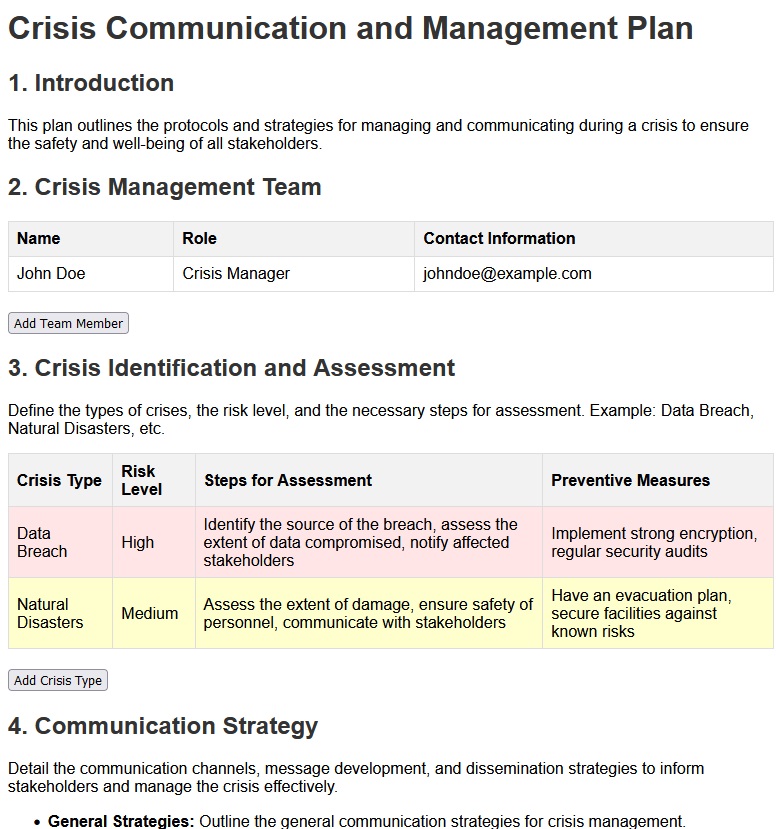
A crisis communication plan prepares you for adverse situations. It outlines how to respond quickly and effectively in a crisis, including the roles and responsibilities of team members and external stakeholders. For example, the plan might include strategies for addressing negative press and restoring public trust in a PR crisis. Who handles media inquiries? Which channels will you use to communicate with customers?
Internal Communication Plan
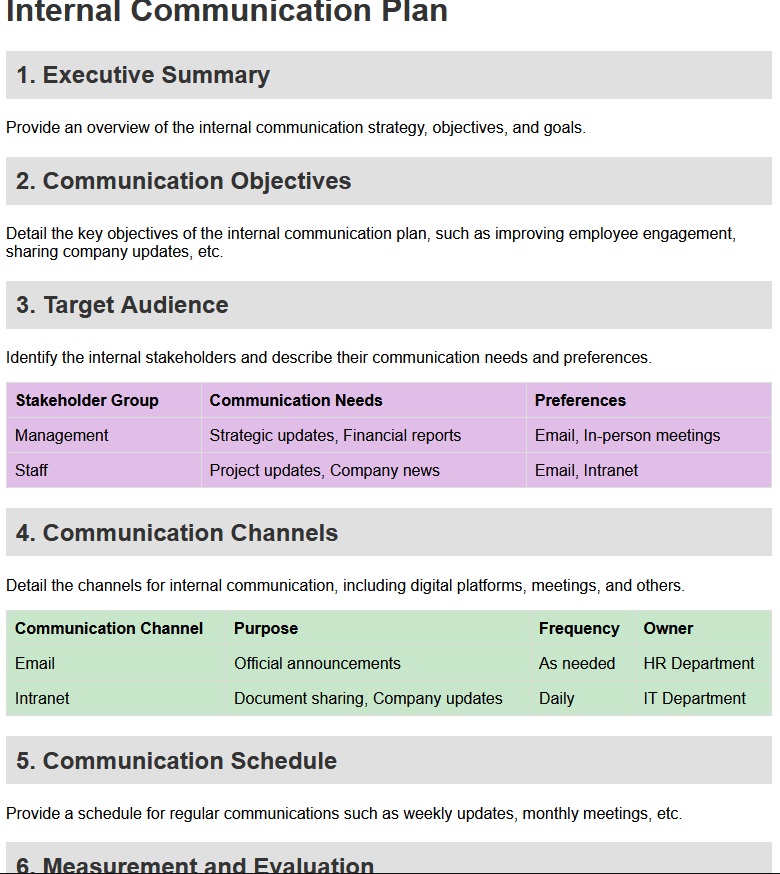
An internal communication plan helps you keep employees informed about company news and decisions. It includes details about who will deliver the message and how, as well as strategies for encouraging employee engagement and feedback. For example, should staff meetings be virtual or in-person? Do you need a dedicated newsletter or intranet?
Marketing Communication Plan
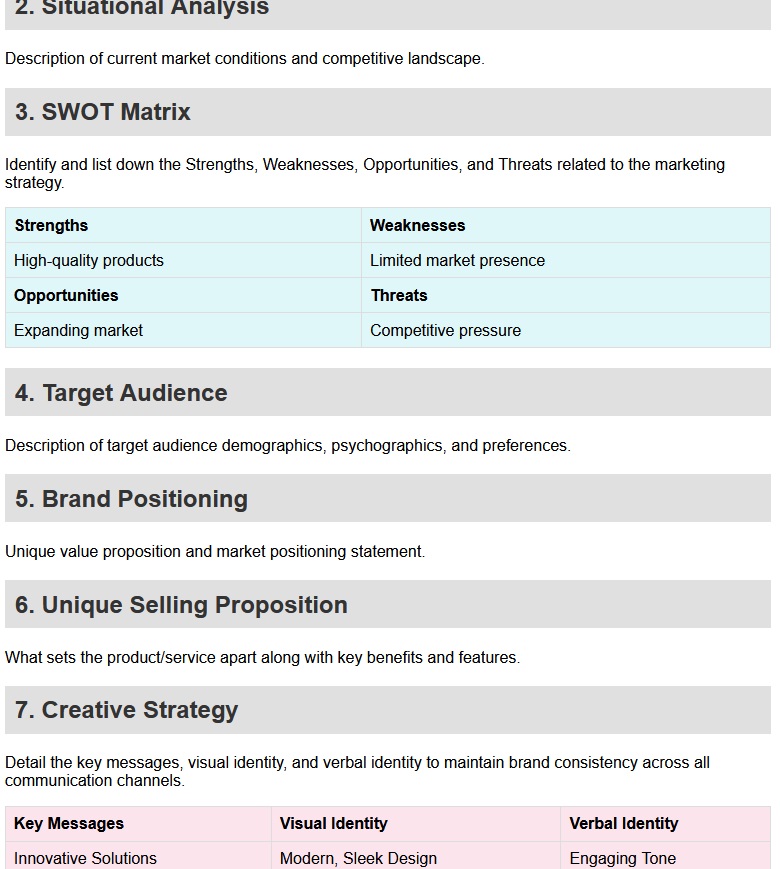
A marketing communication plan guides how to promote content and products. It includes tactics for engaging your intended audience, such as launching campaigns across multiple channels, understanding customer preferences, and leveraging social media influencers. What type of content should you share? How often should you post? What kind of budget do you have?
Project Communication Plan
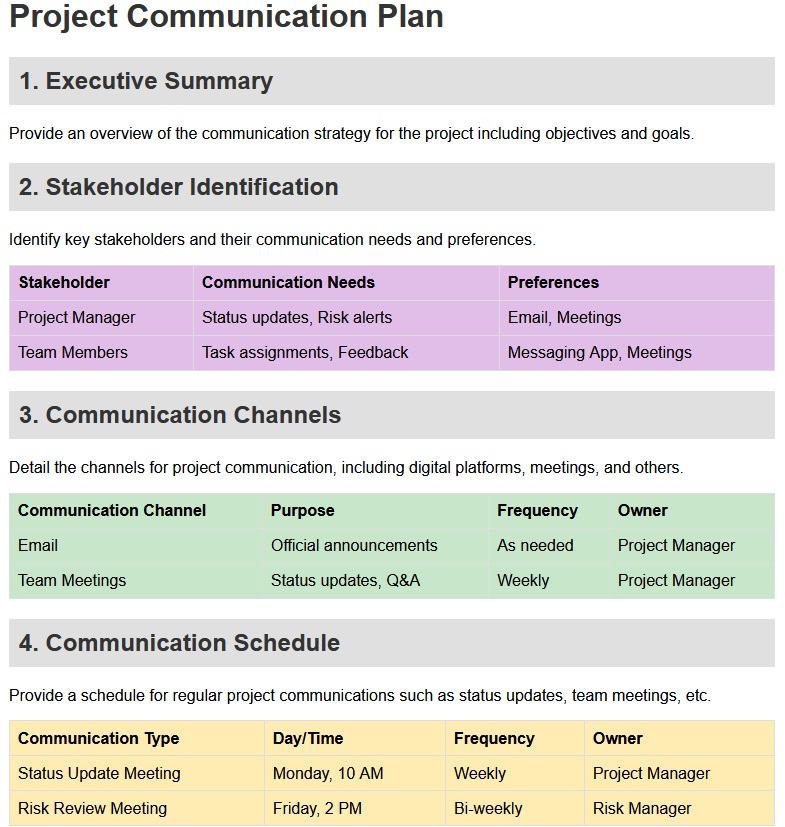
A project communication plan outlines how everyone involved in the project communicates. It sets expectations for delivering updates and progress reports and specifies who manages each task.
It defines the communication methods that should be used—for example, which types of messages are sent by email or text. Additionally, by incorporating a well-defined change control process, the communication plan helps in avoiding scope creep, ensuring that any alterations to the project scope are thoroughly vetted and communicated to all stakeholders.
The goal is to prevent miscommunications, provide a clear timeline for the project, and maintain adherence to the defined project scope, thereby ensuring a smooth and successful project execution
Change Management Communication Plan
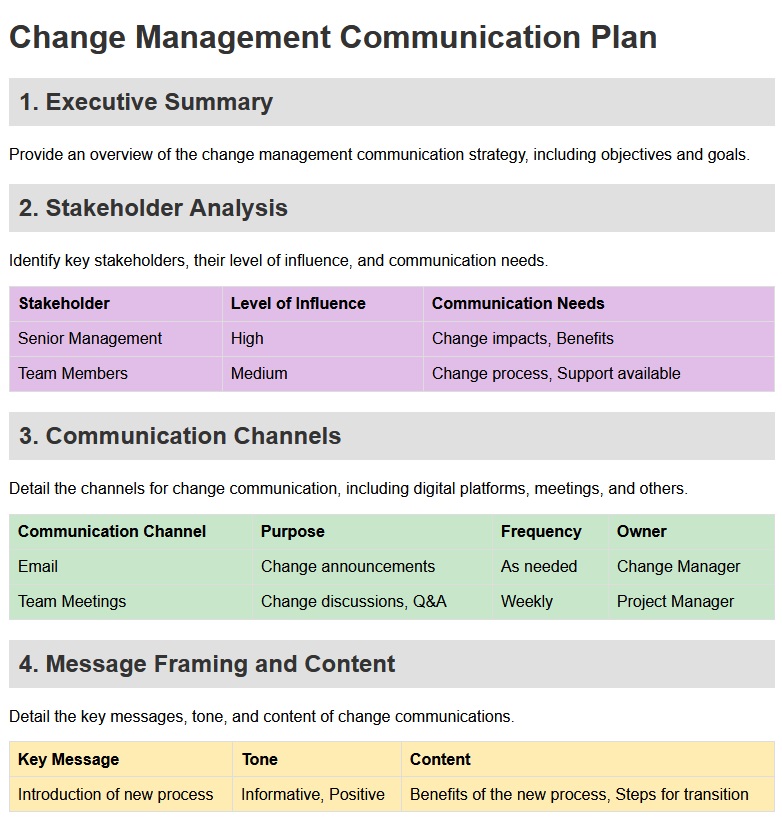
A change management communication plan helps you manage the transition of introducing a new product, procedure, or system. This plan delineates the communication and coordination strategies necessary for engaging stakeholders throughout the changes being made in your organization.
As an example, when rolling out new software, a change management plan specifies the individuals responsible for training employees, identifies any special resources required for smooth adoption, and outlines the approach for addressing customer feedback and complaints. This enables the change management process to be streamlined by ensuring that all stakeholders are well-informed and prepared for the impending changes.
Tools for Distributing Communication Plan
A multi-faceted approach focusing on different channels gets the best results. Here are some tools and channels you can use to distribute your communication plan:
Knowledge Base Software
A centralized repository makes it easier for employees to find answers. Knowledge base solutions such as Helpjuice provide an intuitive platform for storing documents, FAQs, and tutorials—saving time, eliminating errors, and reducing customer support costs.
Capital City Bank, for example, witnessed a decrease in errors on certain reporting by 20% since using Helpjuice. Associates also spend less time searching for information, allowing them more time to complete tasks.
“Helpjuice allows us to centralize our information and job aide resources. The search feature is so powerful that our associates are often able to find the content they are looking for before they even finish typing the search term.”
Social Media Management Tools
Social media management tools like Hootsuite help you coordinate your messaging across multiple social networks. You can schedule and monitor posts, measure engagement rates, and generate detailed analytics reports.
With these insights, you can adjust your strategy to meet customer needs. Social monitoring features also help you detect sentiment and boost customer satisfaction. A communication plan should include designated social media accounts, roles and responsibilities, posting guidelines, and response times.
Email Automation Software
Automated emails can be a powerful tool to deliver fresh content and engage with customers. Distribute communication plans through automated email marketing software such as MailChimp.
These tools include features to segment your lists and set up drip campaigns, so you can send the right message to the right person at the right time. You can also use it to track customer actions and generate detailed analytics reports.
Intranet Systems
An intranet system helps employees collaborate around documents, tasks, and projects in one central location. You can also use this platform to distribute communication plans, send notifications about upcoming events, and clarify roles and responsibilities.
For example, asynchronous communication tools like Slack allows you to create multiple channels for specific projects and topics—streamlining communication processes and making it easier for teams to stay in sync.
Implement a Communication Plan and Streamline Your Processes
A communication plan brings consistency to a project or initiative and helps you manage change. Consider the needs of your audience, select suitable tools and channels, and start crafting a plan that works for everyone.
With the right tools and processes in place, you can ensure that all stakeholders are on the same page—minimizing miscommunications, reducing errors, and ultimately boosting customer satisfaction. Helpjuice can help you create a central hub of information and resources. Get in touch to see how we can help you streamline your internal processes.


![14 Zoom Alternatives for Team-Wide Video Conferencing [2023]](https://static.helpjuice.com/helpjuice_production/uploads/upload/image/4752/direct/1586534415247-1586351118228-Zoom%20Alternatives.png)
![Guide to Training Call Center Agents [2024]](https://static.helpjuice.com/helpjuice_production/uploads/upload/image/12982/3585033/1698261103181-call-center-agent-turnover-previous-5-years-infographic.jpg)

